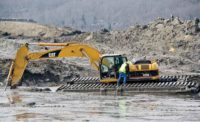The huge caverns being excavated deep underground near Geneva, Switzerland, don’t look that different to those under nearby mountains, ferrying rail and auto traffic through the Alps. But these tunnels serve very different cargo: a train tube isn’t be expected to hold cryomagnets working at minus 270° C, or support miles of massive instruments focusing proton beams at micrometer accuracy.
This is the tunneling now underway as a large cast of engineering firms dig and prepare a multi-year, billion-dollar upgrade to the Large Hadron Collider (LHC), the world’s most powerful particle accelerator, operated by CERN, the European organization for nuclear research.
Project manager Pieter Mattelaer has been donning a hard hat in service of this operation for four years, overseeing a precise schedule an accelerated pace even before the first heavy machines showed up onsite at the end of 2018. There’s still a long way to go; Mattelaer will be watching over the dig for through 2020. Final lining underground is set for 2021. After that comes the complicated underground installation of delicate, irregularly-shaped and large scientific instruments and the accompanying power train: cryogenic systems, superconducting links and magnets.
The LHC is a 27-km circuit located near the airport outside Geneva. It runs under Swiss and French soil for the most part situated in a 3.8-meter track, about 100 m deep, housing a pair of vacuum pipes which contain particle beams. These tunnels periodically open into massive caverns packed tightly with detecting machines that look like they belong on a spaceship. The LHC was first completed in 2008, but construction at CERN takes on a long-term cast that is out of the ordinary. It is a living object: plans are cast years and decades ahead. There are engineers and planners at CERN actively discussing projects for 2040 and even 2080.
The LHC is in shutdown mode while the refit takes place. In order to get new instruments and power train into the collider loop, engineers are constructing two new shafts, 10 m in diameter and 60 m deep (with caverns adding another 25 m, totaling about 85 m deep). There’s about a kilometer’s worth of gallery access tunnels, consisting of wide, high caverns, along with narrower power converter galleries, service and safety tunnels and vertical linkage cores for cabling and service. Crews are busy at two CERN sites along the collider.
When the instruments and power upgrades are installed and the accelerator comes back online, first in 2021 and then again in 2026 after another shutdown-and-refit project, researchers will be able to run experiments with 10 times the number of collisions that can be generated there now. Its rating is already at 13 EV, using enough energy to power a third of nearby Geneva in a given instant as the proton streams fly through the accelerator at near light speed. The beamlines intersect at four points around the ring where the beam collisions take place. The protons smash into each other in bunches, with each proton collision creating, like sparks, new forms of elementary particles.
Physicists can’t visually study the collisions: the particles collisions are reflected in data picked up by the LHC’s detectors. These can be massive assemblies. One of them weighs much as the Eiffel Tower; another, twice as much. The subatomic particles they detect decay and vanish almost instantly. Even so, they exist long enough to leave evidence for the scientists to examine. There is a dizzying variety but most famous currently is the elusive Higgs Boson, a particle predicted to exist in previous decades but actually observed at the LHC, earning a Nobel Prize. All told these particle studies explore and map the fundamental building blocks of matter—the very stuff of the universe.
Right now the collisions going on at the LHC are between borer and rock. Mattelaer came on board in 2015 and had two years to tender the engineering and construction contracts in order to get heavy equipment onsite and excavating the shafts by end 2018, with tunnel digs set up for 2019 and 2020. Using FIDIC Red Book contracting, they set up teams for two sites: a Swiss site with a Swiss building permit and engineering joint venture, and a French site with a French building permit and joint venture. CERN is a 23-member-state organization, however, so there’s a concerted effort to open industry at the site to fair international bid.
The construction consortia assembled for the two sites are headed on the one by JV Marti Meyrin of Switzerland, with Marti Tunnel and both its German and Austrian arms participating; and, on the other, by Implenia (with its experience on the Gotthard Base Tunnel) and Baresel Tunnelbau. The engineering joint ventures include several other members for design and construction management. Taking part is Rocksoil, a specialist tunneling firm which does all of the metro and subway work in Italy; Setec, based in Paris and Lyon, and Lombardi, Artelia, and Pini, three engineering consultancies.
The first digs started in 2018. By February 2019, the contractor dispatched Marti and Implenia custom compact tunnel excavators to the bottom of the main shafts. The machines are powered by electricity to dampen vibrations. Steel radial rock bolts went into the shaft at Point 5, the French site at Cressy. At Point 1, the Swiss site at Meyrin, lattice girders went in every meter or two; these were then embedded in 25cm of shotcrete. By this point the shafts had been sunk to the floor, enough so that a reporter could tour the bottom as the rock bolts were installed that would eventually secure a concrete ring beam at the intersection of the shaft and cavern.
At Meyrin, Marti employs a custom 50-tonne Dutch-built overhead crane for lowering excavators and equipment into the shaft. Implenia Baresel uses a custom-built, German-manufactured 50-ton gantry crane to do the job at Cressy. The Meyrin shaft was big enough to take down a custom-made gantry, which was installed on rails as the horizontal digs got underway. It is being used to install precast invert units, to be followed by the waterproofing cradle and final lining frameworks.
Meanwhile, researchers around the world are looking ahead to getting instruments in these places. University College London physicist Jon Butterworth, who works with the ATLAS detector at Meyrin—just one of the LHC’s big instruments—says it will be an enormously complex operation. For ATLAS alone it means removing the whole of the inner tracking detector, with the old one already showing radiation damage, and replacing it with new detector, a 3-m-long cylinder 1.5 m in diameter.
Getting to that, though, is a major task. ATLAS itself weighs 7,000 tonnes, with its support structure, huge toroid magnets, argon and tile calorimeters, its great 10-m muon-detecting wheels. It is 25 m in diameter and 46 m long, all told, with 80 million sensors covering the area of a tennis court. TRIUMF, the Canadian particle accelerator center, is leading an international effort to develop mobile cryomodules, cooled to 2 kelvin (-456° F), containing machined niobium channels inside a box the size of an industrial freezer. These modules tilt the protein beam in order to gain more collisions: 16 are planned for placing in the LHC, eight for ATLAS and eight for the 14,000-tonne CMS detector at Cressy. These instruments are aligned at micron and sub-micron levels.
Jens Dilling, TRIUMF’s associate lab director for physical sciences, says vibrational requirements and mechanical drift requirements are very tight. “It’s probably similar to an advanced mining operation where you bring heavy equipment underground in very tight constraints,” he says. Butterworth points out that most of the workers at CERN are not physicists—they are engineers. Researchers like him working on the instruments talk to technical coordinators and accelerator physicists, and they talk to the civil engineers doing the building. And when the upgrade is all fixed the instruments will be packed so tightly into the caverns that it’s hard to imagine the scale, Butterworth says, scale he recalls from past tours.
“You can’t see that ATLAS is 50 m long,” he says. “When it was being built, it was another thing. Like an underground cathedral. A cathedral full of cables, magnets and wire.”











Post a comment to this article
Report Abusive Comment